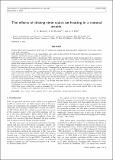The effects of driving time scales on heating in a coronal arcade
Abstract
Context. The relative importance of AC and DC heating mechanisms in maintaining the temperature of the solar corona is not well constrained. Aims. Investigate the effects of the characteristic time scales of photospheric driving on the injection and dissipation of magnetic and kinetic energy within a coronal arcade. Methods. We have conducted three dimensional MHD simulations of complex foot point driving imposed on a potential coronal arcade. We modified the typical time scales associated with the velocity driver to understand the efficiency of heating obtained using AC and DC drivers. We considered the implications for the injected Poynting flux and the spatial and temporal nature of the energy release in dissipative regimes. Results. For the same driver amplitude and complexity, long time scale velocity motions are able to inject a much greater Poynting flux of energy into the corona. Consequently, in non-ideal regimes, slow stressing motions result in a greater increase in plasma temperature than for wave-like driving. In dissipative simulations, Ohmic heating is found to be much more significant than viscous heating. For all drivers in our parameter space, energy dissipation is greatest close to the base of the arcade where the magnetic field strength is strongest and at separatrix surfaces, where the field connectivity changes. Across all simulations, the background field is stressed with random foot point motions (in a manner more typical of DC heating studies) and even for short time scale driving, the injected Poynting flux is large given the small amplitude flows considered. For long time scale driving, the rate of energy injection was comparable to the expected requirements in active regions. The heating rates were found to scale with the perturbed magnetic field strength and not the total field strength. Conclusions. Alongside recent studies which show power within the corona is dominated by low frequency motions, our results suggest that in the closed corona, DC heating is more significant than AC heating.
Citation
Howson , T A , De Moortel , I & Fyfe , L 2020 , ' The effects of driving time scales on heating in a coronal arcade ' , Astronomy & Astrophysics , vol. 643 , A85 . https://doi.org/10.1051/0004-6361/202038869
Publication
Astronomy & Astrophysics
Status
Peer reviewed
ISSN
0004-6361Type
Journal article
Description
Funding: UK Science and Technology Facilities Council (consolidated grant ST/N000609/1), the European Union Horizon 2020 research and innovation programme (grant agreement No. 647214). IDM received funding from the Research Council of Norway through its Centres of Excellence scheme, project number 262622.Collections
Items in the St Andrews Research Repository are protected by copyright, with all rights reserved, unless otherwise indicated.

